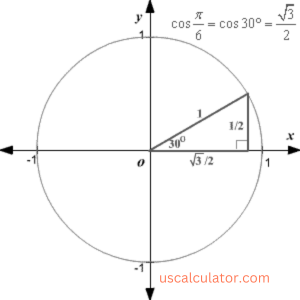

Cosine function calculation example.
Calculation Formula.
cos(θ)=HypotenuseAdjacent Side
We will now calculate the cosine function based on the formula given above. And understand cosine. Suppose you have an adjacent triangle with the adjacent side 4 units long and the hypotenuse (the longest side) 5 units long between the two. You want to find the cosine of the angle between the adjacent side (4 units) and the hypotenuse.
We first need to identify the adjacent side and the hypotenuse. Our adjacent side = 4 units, and the hypotenuse = 5 units. Now we plug these values into the formula. So cos(θ) = 4 units / 5 units. cos(θ) = 0.8 cos(θ) = 4 / 5 units. Cos (θ) = 0.8 (this may be expressed as a fraction as well). Thus, 0.8, or 4/5, is the cosine of the angle in this triangle.
If you calculate antilog based on the antilog calculation formula, but have any doubts, use our Cosine calculator to double-check the findings if you’re not sure.
About Cosine Calculator
The cosine calculator is a helpful tool in today’s digital world. It helps you determine cosine in terms of degrees or radians and angles. If you understand how these calculators work, they are simple to use and accurate.
A straightforward program called Age Calculator determines cosine using degrees or radians and angles.
Understanding Cosine
Cosine Function (cos(x)): Cos(x), the cosine function, helps us to further comprehend angles. It gives an indication of the relationship between the angles of a right triangle in a way that is close to a handy calculator.
Related Trigonometric Functions: Before we delve straight to finding the cosine, we need to be acquainted with sine, sin(x), and tangent, tan(x). As a group, they form the so-called trigonometric functions triad. To learn the mysteries of angles, they join hands.
How to Calculate an Angle’s Cosine: We can therefore see that if we have to find the cosine of an angle, we would not have a problem getting it. It turns out that there is an easy way to achieve all that, and here’s the formula. Take an angle and apply the cosine of it, and voilà! The result lay between -1 and 1 as a value. As the angle increases, the outcome approaches -1 or 1, and this feature is desirable while computing machine learning algorithms.
Uses for the Cosine Function: Now, you might ask why cos(x) is useful and appeals to practical purposes. Others extend it beyond purely arithmetical terms; it is applicable in almost every field of study.
Frequently Asked Questions (FAQ)
1. What are the key angles and their cosine values?
- Here are some commonly used angles and their cosine values:
- cos(0°) = 1
- cos(30°) =
- cos(45°) =
- cos(60°) =
- cos(90°) = 0
- cos(0°) = 1
- cos(30°) =
- cos(45°) =
- cos(60°) =
- cos(90°) = 0
2. How do I convert an angle from degrees to radians for use in the Cosine Calculator?
- To convert degrees to radians, you can use the formula:
For example, 45° is equivalent to radians.
Common Cosine values table
| x (deg) | x (rad) | sine(x) |
|---|---|---|
| 0° | 0 | 1 |
| 30° | π/6 | 0.866025 |
| 45° | π/4 | 0.707107 |
| 60° | π/3 | 0.50 |
| 90° | π/2 | 0 |
| 120° | 2π/3 | -0.50 |
| 135° | 3π/4 | -0.707107 |
| 150° | 5π/6 | -0.866025 |
| 180° | π | -1 |
Cosine Table
| Angle (degrees) | Angle (radians) | Cos X |
|---|---|---|
| 0° | 0 | 1 |
| 15° | π / 12 | √6 + √2 / 4 |
| 30° | π / 6 | √3 / 2 |
| 45° | π / 4 | √2 / 2 |
| 60° | π / 3 | 1 / 2 |
| 75° | 5 π / 12 | √6 - √2 / 4 |
| 90° | π / 2 | 0 |
| 105° | 7 π / 12 | - √6 - √2 / 4 |
| 120° | 2 π / 3 | - 1 / 2 |
| 135° | 3 π / 4 | - √2 / 2 |
| 150° | 5 π / 6 | - √3 / 2 |
| 165° | 11 π / 12 | - √6 + √2 / 4 |
| 180° | π | - 1 |
| 195° | 13 π / 12 | - √6 + √2 / 4 |
| 210° | 7 π / 6 | - √3 / 2 |
| 225° | 5 π / 4 | - √2 / 2 |
| 240° | 4 π / 3 | - 1 / 2 |
| 255° | 17 π / 12 | - √6 - √2 / 4 |
| 270° | 3 π / 2 | 0 |
| 285° | 19 π / 12 | √6 - √2 / 4 |
| 300° | 5 π / 3 | 1 / 2 |
| 315° | 7 π / 4 | √2 / 2 |
| 330° | 11 π / 6 | √3 / 2 |
| 345° | 23 π / 12 | √6 + √2 / 4 |
| 360° | 2 π | 1 |
Cosine Function
A few cosine values based on 30°−60°−90° and 45°−45°−90° triangles should be committed to memory.


